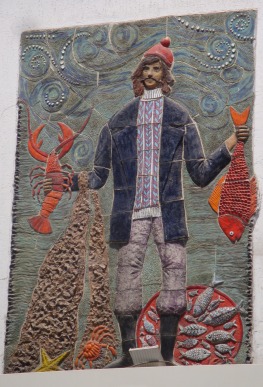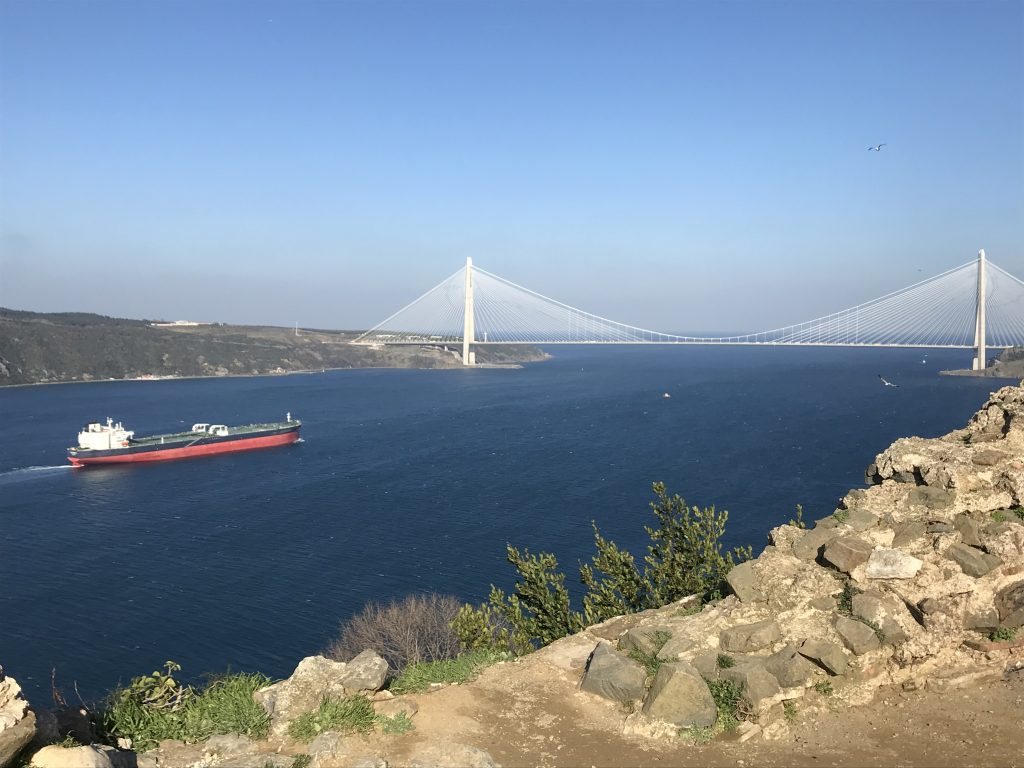“Cow’s Passage”
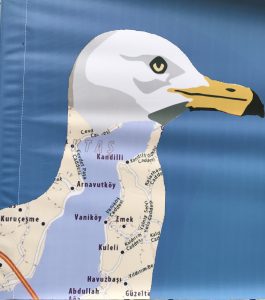 Anyone fortunate enough to live in İstanbul knows that one of its greatest delights is the glorious Bosphorus (Boğaz in Turkish), the strait that meanders through the city and divides the European side from the Asian one. The Bosphorus takes its name from a Greek myth according to which Zeus’ jealous wife Hera sent a gadfly to annoy the cow into which her husband had changed his latest mistress, Io, in an attempt to protect her. Irritated by the fly, Io roamed the globe until finally arriving in Egypt where Zeus changed her back into human form. The “Cow’s Passage” was the point at which she left Europe for Asia.
Anyone fortunate enough to live in İstanbul knows that one of its greatest delights is the glorious Bosphorus (Boğaz in Turkish), the strait that meanders through the city and divides the European side from the Asian one. The Bosphorus takes its name from a Greek myth according to which Zeus’ jealous wife Hera sent a gadfly to annoy the cow into which her husband had changed his latest mistress, Io, in an attempt to protect her. Irritated by the fly, Io roamed the globe until finally arriving in Egypt where Zeus changed her back into human form. The “Cow’s Passage” was the point at which she left Europe for Asia.
It goes without saying that landing a Bosphorus view is the sine qua non of wealthy house-hunters, hoteliers and restaurateurs with an eye to the money. Even today when there are far fewer of the wonderful wooden yalıs (waterside mansions) than there used to be, the Bosphorus is still lined with properties that sell for eye-watering sums of money, right up there in the real estate premier league with the most expensive homes in London and New York.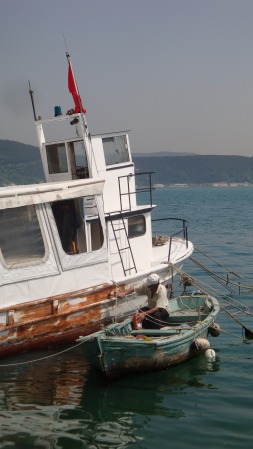 A local fishing fleet still plies the waters of the BosphorusVisitors to the city may only be able to dream of seeing behind their elegant facades, but they can gaze out on them in envy from the decks of the many Bosphorus excursion boats.
A local fishing fleet still plies the waters of the BosphorusVisitors to the city may only be able to dream of seeing behind their elegant facades, but they can gaze out on them in envy from the decks of the many Bosphorus excursion boats.
Those in a hurry may have to make do with one of the shorter cruises operated out of Eminönü by private companies. But for the real McCoy it’s best to set aside enough time for one of the longer cruises operated daily by the İstanbul ferry company, Şehir Hatları. They too leave from Eminönü although you’ll need to give the pushy private ticket touts the slip if you want to use them.
There are many wonderful things about a leisurely Bosphorus cruise. In the first place you get to see the city free of the smog, noise and traffic jams. Secondly, you get to see it as it was originally viewed by those who built the yalıs and palaces along its shores – since there was no coast road in the 19th century people had to move between the various Bosphorus villages (as they were then) using a fleet of public and private boats. Thirdly, you get to observe the wildlife that haunts the water – most obviously the seagulls, who dive enthusiastically to snatch the pieces of simits tossed to them, but also the flocks of tiny shearwaters that skim the water and the cormorants who spread their wings on every available resting post, then dive for any fish foolish enough to swim past.
The luckiest passengers of all even get to glimpse the pods of dolphins that have returned to the Bosphorus now that its waters have been cleaned up.
To make the most of your trip get to the landing stage early so that you can grab one of the seats on deck or by the windows. The excitement starts almost immediately as the boat pulls away from the jetty, leaving the Galata Bridge and its ever-present anglers behind and sauntering past Sarayburnu (Seraglio Point), the place where Byzantine history really began.
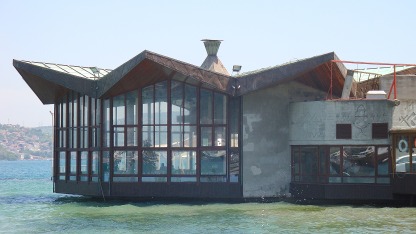 The many fish restaurants are one of the joys of the BosphorusHigh up on the hillside through the greenery of Gülhane Park you’ll see the tower and chimneys of Topkapı Palace with, behind them, the four soaring minarets of Hagia Sophia (Ayasofya), the Emperor Justinian’s great 6th-century church turned 21st-century mosque.
The many fish restaurants are one of the joys of the BosphorusHigh up on the hillside through the greenery of Gülhane Park you’ll see the tower and chimneys of Topkapı Palace with, behind them, the four soaring minarets of Hagia Sophia (Ayasofya), the Emperor Justinian’s great 6th-century church turned 21st-century mosque.
Beyond Sarayburnu the ferries swivel left and start their journey north towards the Black Sea. Looking towards the Asian shore you’ll see the pretty little Maiden’s Tower (Kızkulesi) at Üsküdar, frequently rebuilt over the centuries and subject to a fairly predictable story involving an imprisoned princess, a basket of fruit and a lethal hidden snake. It’s near here that the Marmaray tunnel passes under the Bosphorus to link Europe with Asia.
Back on the European shore the ferry meanders past Tophane, the site of the old arsenal, and the redundant warehouses that have become the Galataport. Shortly afterwards you’ll see the glistening white building that houses the Dolmabahçe Palace to which the sultans retreated in the middle of the 19th century as they struggled to modernise/Westernise their administrations. Whereas the old Topkapı Palace had been a cluster of anonymously designed chambers and pavilions grouped around a set of courtyards, Dolmabahçe was more solidly palatial, the handiwork of Garabet and Nikoğos Balyan, scions of a family of prolific Turkish-Armenian architects.
As the ferry continues northwards you’ll spot two of the city’s finest hotels, the Four Seasons at the Bosphorus and the Çırağan Palace Kempinski, gazing out towards it. Shortly afterwards the First Bosphorus Bridge looms up ahead of you. Erected in 1973, it provides a vital lifeline for the city, although convenience for commuters was bought at the price of imposing traffic noise virtually on top of the graceful Ortaköy Mosque on the European shore and the elegant Dolmabahçe Palace-in-miniature that is the Beylerbeyi Palace on the Asian shore. Both these buildings were further works of the Balyan family: Nikoğos designed the mosque in 1854-5 while Sarkis designed the palace in 1865. The Bridge was renamed the 15 Temmuz Şehitler Köprüsü (15th July Martyrs Bridge) following the failed coup of 2016.
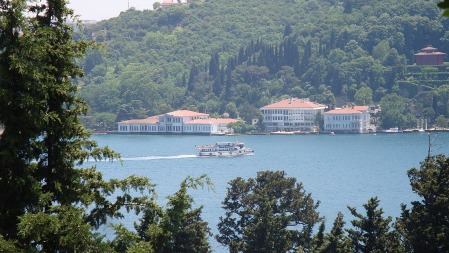 Bosphorus yalıs at KandilliBeyond the Bosphorus Bridge you start to feel the city falling away from you even though both shores of the strait are still completely built-up. On the European shore you will sail past Kuruçeşme, a popular nightlife centre, and Arnavutköy where a line-up of delightful wooden yalıs hints at what was lost as fire wrote off some old buildings and others were torn down to make way for modern blocks of flats.
Bosphorus yalıs at KandilliBeyond the Bosphorus Bridge you start to feel the city falling away from you even though both shores of the strait are still completely built-up. On the European shore you will sail past Kuruçeşme, a popular nightlife centre, and Arnavutköy where a line-up of delightful wooden yalıs hints at what was lost as fire wrote off some old buildings and others were torn down to make way for modern blocks of flats.
On the Asian shore meanwhile you won’t be able to miss the fairy-tale towers of the Kuleli Military School, one of whose pupils was Irfan Olga who went on to write the wonderful A Portrait of a Turkish Family.
Beyond Arnavutköy the Bosphorus narrows and two castles jut up on the skyline. The older of the two is Anadolu Hisarı on the Asian side which has suffered the indignity of being sliced in two by the modern shore road. Bigger and far more impressive is Rumeli Hisarı, built by Sultan Mehmed II as he planned his assault on Constantinople in 1452 and restored in the 2020s. Right beside it looms the second Bosphorus bridge which went up in 1988 and was named, not altogether surprisingly, the Fatih Sultan Mehmet Bridge.
As the ferry continues its slow journey northwards it bypasses on the European shore two wonderful and under-visited private museums, the Sakıp Sabancı Museum in Emirgan which plays host to many of the city’s blockbuster exhibitions, and the Sadberk Hanım Museum in Büyükdere which houses permanent collections of archaeology and ethnography.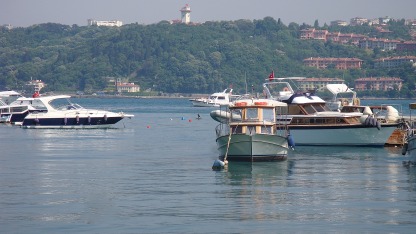 Looking across the Bosphorus with the Khedive’s Villa at Çubuklu in the distance
Looking across the Bosphorus with the Khedive’s Villa at Çubuklu in the distance
Between the two more magnificent yalıs line the shore at Yeniköy while there are reminders of the days when the foreign embassies maintained summer residences on the Bosphorus at Tarabya.
The ferries come to the end of their European run at Rumeli Kavağı, a small settlement with a cluster of fish restaurants, before shimmying across to Anadolu Kavağı on the Asian shore and yet more fish restaurants.
Energetic passengers can disembark here and stride uphill to inspect the remains of Yoros Castle which was built by the Byzantines and then taken over by the Genoese in the 14th century. From here you can look north towards the Black Sea and down on the Third Bosphorus bridge, controversially named the Yavuz Sultan Selim Bridge, that runs between once sleepy little Garipçe on the European shore and Poyrazköy, a beach resort named after the chilly wind that whips through it in winter, on the Asian shore.
Bosphorus Swimathon Every July competitors race across the Bosphorus from Kuruçeşme to Kanlıca. In 2000 someone completed the 6.5km swim in 39 minutes, setting a record that is yet to be beaten.
Transport info
The long Bosphorus cruise boats make only limited stops, at Beşiktaş, Kanlıca (a suburb famous for its yoghurt), Yeniköy, Sarıyer, Rumeli Kavağı and Anadolu Kavaği. Once you’ve got the lie of the land, however, there’s nothing to stop you using the local ferries to explore at your own pace. Many services only operate in the morning and evening to suit the needs of commuters but there’s are also useful coastal-hop services running up and down the European and Asian shores.
Individual timetables are posted at the ferry landing stages. Better still, pick up the complete timetable at Eminönü, or go to www.sehirhatlari.com.tr.
